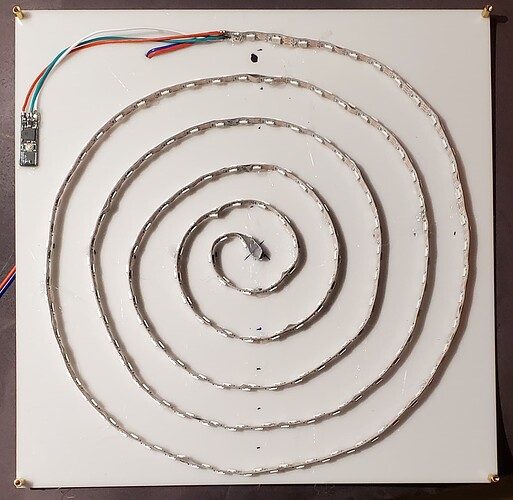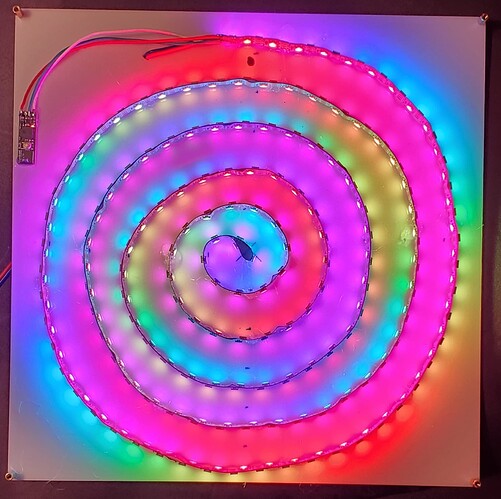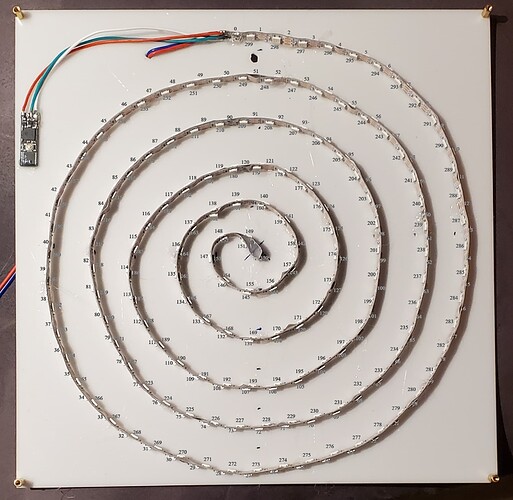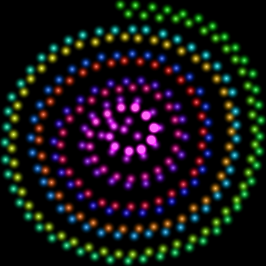@wizard just tried StarGen 2D pattern on my spiral. It looks much better vs 16x16 matrix.
Of course, my spiral is not geometrically ideal. I tried my best, it looks about right but
could be better if I was not lazy and draw an ideal mathematical spiral guide line
before gluing LEDs.
Just in case, here is my JSON map for this double sided spiral.
Photos how it looks are in this post above.
[
[745,91],
[824,93],
[914,103],
[992,118],
[1075,141],
[1157,165],
[1231,208],
[1294,267],
[1351,326],
[1398,396],
[1443,470],
[1459,558],
[1474,642],
[1486,726],
[1480,815],
[1477,897],
[1463,974],
[1436,1062],
[1399,1133],
[1361,1204],
[1310,1273],
[1253,1335],
[1181,1391],
[1109,1426],
[1033,1455],
[955,1476],
[865,1490],
[786,1501],
[692,1494],
[610,1475],
[535,1450],
[462,1416],
[385,1375],
[319,1316],
[260,1254],
[214,1180],
[182,1104],
[154,1023],
[140,943],
[137,848],
[147,763],
[154,677],
[173,598],
[221,524],
[271,449],
[330,381],
[394,329],
[472,286],
[547,257],
[634,237],
[717,230],
[810,225],
[880,228],
[970,250],
[1045,280],
[1120,324],
[1196,368],
[1255,428],
[1304,496],
[1336,572],
[1352,677],
[1357,752],
[1357,828],
[1347,919],
[1324,999],
[1303,1073],
[1257,1141],
[1196,1213],
[1137,1264],
[1063,1316],
[983,1342],
[894,1351],
[818,1363],
[731,1359],
[644,1346],
[566,1315],
[491,1270],
[431,1213],
[378,1141],
[341,1065],
[309,992],
[282,905],
[274,822],
[291,721],
[321,642],
[365,559],
[422,503],
[491,445],
[563,410],
[645,378],
[727,370],
[808,360],
[889,369],
[964,386],
[1040,439],
[1110,487],
[1165,567],
[1195,651],
[1207,738],
[1211,822],
[1205,909],
[1178,997],
[1137,1068],
[1082,1120],
[1016,1173],
[950,1220],
[862,1236],
[777,1237],
[687,1225],
[602,1196],
[535,1145],
[483,1080],
[435,1014],
[403,929],
[395,843],
[422,746],
[463,674],
[535,613],
[610,561],
[694,524],
[776,512],
[854,508],
[928,533],
[999,580],
[1045,651],
[1072,721],
[1087,817],
[1067,916],
[1023,988],
[954,1041],
[879,1075],
[786,1084],
[700,1062],
[622,1014],
[572,952],
[544,864],
[557,771],
[597,701],
[673,642],
[745,613],
[835,619],
[916,682],
[954,768],
[929,861],
[867,922],
[778,938],
[701,900],
[646,809],
[692,729],
[789,730],
[836,813],
[764,777],
[711,759],
[688,816],
[716,869],
[791,896],
[855,886],
[908,834],
[922,768],
[880,700],
[823,656],
[749,656],
[677,690],
[616,734],
[584,801],
[585,871],
[609,940],
[657,997],
[726,1036],
[801,1049],
[875,1036],
[942,1002],
[1000,953],
[1036,883],
[1050,801],
[1033,724],
[1002,652],
[945,593],
[882,551],
[810,546],
[739,556],
[664,573],
[594,616],
[531,666],
[478,718],
[443,794],
[430,861],
[441,942],
[475,1012],
[525,1071],
[575,1130],
[649,1180],
[718,1197],
[801,1202],
[875,1196],
[947,1171],
[1016,1130],
[1077,1079],
[1134,1014],
[1162,951],
[1175,866],
[1182,789],
[1174,704],
[1146,627],
[1115,564],
[1064,504],
[999,452],
[927,420],
[849,403],
[766,398],
[697,411],
[618,430],
[548,463],
[478,508],
[418,562],
[376,623],
[339,694],
[317,771],
[316,835],
[331,923],
[350,1002],
[382,1069],
[422,1141],
[473,1208],
[533,1256],
[602,1291],
[683,1320],
[759,1326],
[843,1323],
[921,1313],
[994,1296],
[1070,1269],
[1131,1210],
[1197,1168],
[1246,1101],
[1277,1033],
[1303,954],
[1319,872],
[1331,788],
[1322,709],
[1316,643],
[1291,570],
[1253,498],
[1199,431],
[1143,387],
[1067,345],
[990,309],
[923,285],
[838,275],
[769,267],
[688,272],
[613,295],
[529,309],
[458,344],
[387,383],
[330,440],
[273,498],
[237,571],
[203,645],
[188,715],
[182,804],
[173,881],
[185,962],
[203,1040],
[227,1121],
[263,1196],
[314,1256],
[369,1314],
[435,1363],
[500,1396],
[579,1426],
[658,1449],
[736,1463],
[810,1465],
[895,1451],
[970,1435],
[1043,1408],
[1127,1380],
[1194,1339],
[1251,1288],
[1301,1228],
[1358,1165],
[1393,1089],
[1420,1014],
[1434,940],
[1455,859],
[1453,776],
[1441,696],
[1432,617],
[1417,536],
[1388,459],
[1351,391],
[1304,333],
[1247,274],
[1186,233],
[1106,191],
[1037,167],
[951,162],
[869,149],
[787,140]
]
I experimented with multiple different LED layout.
Originally I thought about 32x32 Matrix right behind the picture with the diffuser.
May be the diffuser is/was not a right one but my wife did not like how it looked.
She did not like well visible dots when LEDs where right behind the diffuser.
When I moved LEDs a bit away dots disappeared but she still did not like it.
Single sided spiral looked good but produced very uneven light distribution
plus spiral itself was very well pronounced. Finally double sided spiral was
accepted and made into final design. I interleaved LEDs on both sides.
This increased LED density but strip became twice shorter, i.e. twice less spiral
turns. But visually this looks much better.
Right now this picture frame runs two patterns.
One is a built-in spiral twirls 2D
It runs a bit faster than desired but all my attempts to slow it down failed.
The pattern becomes destroyed instead just slowing speed down.
Second on is a Rotating Star.
I modified a Geomorph 2D code created by @zranger1 and left only
slowly rotating hex star.
Once again - Thank you all for very valuable ideas and hints how
to create a desired result.






